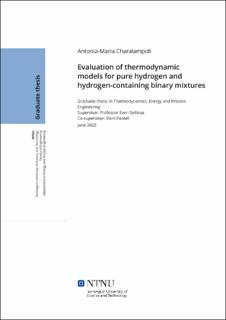| dc.description.abstract | Since the world is moving towards a new era which is based on zero greenhouse gas emissions in the atmosphere and renewable resources, emphasis should be placed on a substitute solution for the fossil fuels; hydrogen. Pure hydrogen, which is mainly produced by methane steam reforming and secondarily by water electrolysis in significantly fewer quantities, can be the “green weapon” against today’s environmental crisis. Nevertheless, in order to achieve the transition from fossil fuels to hydrogen, it is important to test if the existing pipeline and storage system that is used for natural gas streams can be applicable to hydrogen-containing streams as well.
In this work the main focus is paid to the properties related to pipeline design and storing-conditions determination for the cases of pure hydrogen and of binary mixtures between hydrogen and basic natural-gas components. More specifically, several thermodynamic models have been evaluated in terms of prediction-accuracy comparing to the available online experimental datasets of the desired examined properties.
The properties of major importance as it comes to transporting and storage are; vapor pressures, as it comes to pure components, or vapor-liquid equilibrium information, as it comes to mixtures, which can be used to properly determine the operating conditions of the production chain for the desired mixture-phases, the system’s density, which is important for calculating the frictional pressure loss inside a pipe, the residual parts of the energetic properties of molar heat capacity and enthalpy and also JT coefficient, which are important for determining temperature changes of a fluid, and lastly the speed of sound, which is important for defining the critical mass flux of pipeline flows.
Additionally, the components that were considered as components of interest and were examined when mixed with hydrogen in terms of binary mixture were the main components of natural gas stream that can be found in hydrogen’s production via steam reforming and these are: methane, which is the most important one, ethane, propane, carbon monoxide, carbon dioxide and nitrogen.
Lastly, the thermodynamic models that have been tested for the abovementioned calculations are; GERG-2008 EoS which is the reference equation for natural gas streams and similar gases’ streams and it is important to see if it can be trusted for mixtures of components of these streams when mixed with large quantities of hydrogen, the classic cubic equations of state Peng-Robinson and Soave-Redlich-Kwong which are very simple to use and are reliable for various mixtures regardless their simplicity, a more complicated statistical model such as Perturbed-Chain SAFT equation of state and lastly the UMR-PRU predictive model which is the PR EoS coupled with UNIFAC through the Universal Mixing Rule.
After a detailed searched on the available online literature, various experimental data points referring the abovementioned systems of pure hydrogen and hydrogen-containing binary mixtures were collected. The data available for pure hydrogen were plenty, they were reliable and lead to safe conclusions as it comes to the model accuracy comparison. This was not the case for the data available for the binary mixtures. The thermophysical property data have been extracted mainly from rather old sources, since there were no up-to-date data found, and have a clear focus on single phase density values for the systems of hydrogen mixed with methane, carbon dioxide or nitrogen for very low concentration of hydrogen in the mixtures. Based on such data, it is not possible to draw safe conclusions regarding modern processes related to hydrogen production, since these will be based on high hydrogen concentrations. The available vapor-liquid equilibrium data led to safer results.
From the thermodynamic model comparison, it was concluded that the GERG-2008 EoS can be used as a reference equation for pure hydrogen since it gave the best results in all of the calculations. GERG-2008 EoS can also be trusted for the single-phase density and the sound velocity calculations of the six binary mixtures regarding the experimental data. Since the data fail to cover a wide range of hydrogen compositions, GERG-2008 EoS was used to extend the existing database for single-phase density and speed of sound data in higher hydrogen compositions and it was found that the rest of the thermodynamic models give similar results for a composition range from 0 % to 100 % hydrogen, with SRK EoS being the most reliable comparing to the GERG-2008 EoS. Both in case of pure hydrogen and hydrogen-containing binary mixtures, no model can predict well enough the residual part of heat capacities or the Joule-Thomson coefficient. The vapor-liquid equilibrium calculations were better performed by UMR-PRU EoS.
It is a fact now that for these six binary mixtures the models that can predict satisfactorily their thermophysical properties do not succeed on vapor-liquid equilibrium and vise versa. Due to this fact, the binary interaction parameters of the mixtures for, indicatively, PR EoS were properly determined, after carrying out fittings to the bubble point pressure experimental data in order to realize if this technique can lead the equations of state to achieve better accuracy for both property and vapor-liquid equilibrium calculations.
Finally, it was concluded that if a certain model should be proposed for each one of the examined systems these models would be; GERG-2008 Eos for pure hydrogen, hydrogen-propane and hydrogen-carbon monoxide, UMR-PRU EoS for hydrogen-ethane and hydrogen-carbon dioxide and lastly PR EoS with fitted acentric factor for hydrogen and fitted binary interaction parameters for hydrogen-methane and hydrogen-nitrogen.
Key Words: Data evaluation for hydrogen-containing systems, Thermodynamic modeling of pure hydrogen, Thermodynamic modeling of hydrogen-containing binary systems, GERG-2008 EoS evaluation of hydrogen-containing systems | |
